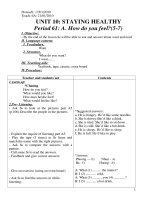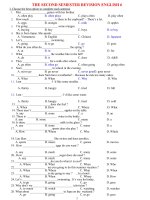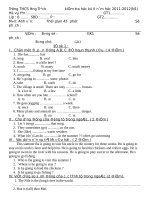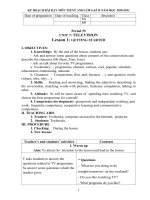anh 6 Ki II
Bạn đang xem bản rút gọn của tài liệu. Xem và tải ngay bản đầy đủ của tài liệu tại đây (102.24 KB, 13 trang )
<span class='text_page_counter'>(1)</span><div class='page_container' data-page=1>
Preteach: 17/01/2010
Teach: 6A: 21/01/2010
<b>unit 10: staying healthy</b>
<i><b>Period 61: A. How do you feel?(5-7)</b></i>
<i><b>I. Objective:</b></i>
- By the end of the lesson Ss will be able to ask and answer about want and need
<i><b>II. Language content:</b></i>
<i><b> </b></i>
<i><b> 1. Vocabulary. </b></i>
Want
<b> 2. Structure.</b>
What do you want?
I want...
<i><b>III. Teaching aids:</b></i>
Textbook, tape, casette, extra-board
<i><b>IV.Procedure:</b></i>
<b>Teacher and students act</b>’ <b>Contents</b>
<i><b>1.warm up:</b></i>
<b> *Chating </b>
How do you feel?
What would you like?
How does he/she feel?
What would he/she like?
<i><b>2.Pre- Listening</b>:<b> </b></i>
- Ask Ss to look at the pictures part A5
(p.106).Describe the people in the pictures
- Explain the require of listening part A5.
- Play the tape (3 times) to Ss listen and
match the name with the right pictures.
- Ask Ss to compare the answers with a
partner.
- Call some Ss to read the answers.
- Feedback and give correct answers:
- Give an exercise (using an extra-board)
- Ask Ss to find the answers in while-
listening.
<i><b>3. While- Listening:</b></i>
- Play the tape part A6 (p.106) to Ss listen
and complete the dialogue above.
- Call some pairs to practice the dialogue.
- Feedback and give correct answers:
- Explain structure
- Ask Ss some questions.
+ What’s the matter with, Dung?
<i> (She is cold)</i>
*Suggested answers:
a, He is hungry. He’d like some noodles.
b, She is thirsty.She’d like a drink.
c, She is tited. She’d like to sit down .
d, She is cold. She’d like a hot drink.
e, He is sleepy. He’d like to sleep.
f, He is full. He’d like to play.
*Answer:
Phuong – b) Nhan - a)
Ba - f) Huong - d)
A: What (1) ... the matter?
B: I (2) ... cold.
A: What (3) ...you (4)...?
B: I (5) ... a hot drink.
*Answer:
(1).is (2).am (3).do (4).want
(5).want
</div>
<span class='text_page_counter'>(2)</span><div class='page_container' data-page=2>
+ What does she want?
<i>(She wants a hot drink)</i>
<b> *Work in pairs.</b>
- Make the dialogues with cues-word given.
<i>a, Hot/ cold drink.</i>
<i>b, Hungry/ noodles.</i>
<i>c, Thirsty/ a drink.</i>
- Call some Ss to practice in front of the
class.
- Feedback.
<i><b>4.Post- Listening:</b></i>
<b>*Survey: Talk about feeling of your </b>
Partners.
<i><b>5. Consolidation:</b></i>
- Read part remember A8 (p.107)
<i><b>6. Homework:</b></i>
+ What’s the matter? = How do you
feel?
<b>*Suggested similar dialogues:</b>
S1: What’s the matter?
S2: I’m hot.
S1: What do you want?
S2: I want a cold drink
………….
tired hungry Thirsty cold
Lan
Mai
Hung
...
- Do exercises 3,4 page 88 in workbook.
- Pre- next lesson unit10 parts B1,2,3
<b> </b>
<b>1.warm up.</b>
<b> *Chating </b>
How do you feel?
What would you like?
How does he/she feel?
What would he/she like?
<b> 2.Pre- Listening.</b>
- Ask Ss to look at the pictures part A5 (p.106).Describe the people in the
pictures
*Suggested answers:
a, He is hungry. He’d like some noodles.
b, She is thirsty.She’d like a drink.
</div>
<span class='text_page_counter'>(3)</span><div class='page_container' data-page=3>
e, He is sleepy. He’d like to sleep.
f, He is full. He’d like to play.
- Explain the require of listening part A5.
- Play the tape (3 times) to Ss listen and match the name with the right pictures.
- Ask Ss to compare the answers with a partner.
- Call some Ss to read the answers.
- Feedback and give correct answers:
Phuong – b) Nhan- a) Ba- f) Huong- d)
- Give an exercise (using an extra-board)
A: What (1) ... the matter?
B: I (2) ... cold.
A: What (3) ...you (4)...?
B: I (5) ... a hot drink.
- Ask Ss to find the answers in while- listening.
3. While- Listening.
- Play the tape part A6 (p.106) to Ss listen and complete the dialogue above.
- Call some pairs to practice the dialogue.
- Feedback and give correct answers:
(1).is (2).am (3).do (4).want (5).want
- Explain structure: What do you want?
I want ...
+To want (v): muèn
+ What’s the matter? = How do you feel?
- Ask Ss some questions.
+ What’s the matter with, Dung? (She is cold)
+ What does she want? (She wants a hot drink)
<b> *Work in pairs.</b>
- Make the dialogues with cues-word given.
<i>a, Hot/ cold drink.</i>
<i>b, Hungry/ noodles.</i>
<i>c, Thirsty/ a drink.</i>
- Call some Ss to practice in front of the class.
- Feedback.
4.Post- Listening.
<b> *Survey: Talk about feeling of your partners.</b>
tired hungry Thirsty cold
Lan
Mai
Hung
...
<b> 5. Consolidation.</b>
- Read part remember A8 (p.107)
<b> 6. Homework.</b>
- Do exercises 3,4 page 88 in workbook.
- Pre- next lesson unit10 parts B1,2,3
Teach: unit10: staying healthy
Period62: lesson 3: B Food and drink
I. Objective:
By the end of the lesson Ss will be able to identify food and drink.
II.Language content:
1. Vocabulary.
</div>
<span class='text_page_counter'>(4)</span><div class='page_container' data-page=4>
2.Structure.
What is for lunch?
+ Is there any meat?
Yes, there’s some.
No, there isn’t any.
+ Are there any noodles?
Yes, there are some.
No, there aren’t any.
III. Teaching aids:
Textbook , tape ,casette, picture part B1(p.108), some real objects
IV.Procedure:
1.Warm up.
*Jumbled words
1. maettr
2. dnooles
3. hnugry
4. anwt
5. leef
Answers: 1) matter 2) noodles 3) hungry 4) want 5) feel
2. Pre- listening.
*Pre-teach vocabulary (using real objects)
+ apple (n): + rice (n):
+ orange (n): + milk (n):
+ banana (n): + meat (n):
+ water (n): + vegetable (n):
*Checking vocabular: Rub out and remember
- Play the tape part B1(108) to Ss listen and repeat.
- Call on some Ss to read new words.
- Introduce structure
+ What is there to drink?
There is some water
to drink (v):
+ What is there to eat?
to eat (v):
- Ask Ss to look at part B1 p.108 and answer the questions
+ What is there to drink? (There is some water and milk)
+ What is there to eat? (There is some meat, rice ...)
- Introduce the content of listening.( Phuong and Thu are asking answering about
food and drink for lunch.)
- Give the table.
noodles
meat
banana
milk
rice
water
orange
3. While- listening.
- Play the tape B2 for twice to Ss listen and tick ( ) the food or drink which
Phuong and Thu will eat or drink.
- Correct the table in pre-listening.
- Call some pairs to practice the dialogue in front of the class.
- Explain the structure: + What's for lunch?
There is some meat and some rice.
- Ask Ss to practice with "breakfast"and "dinner"
Ex: S1: What' s for breakfast?
</div>
<span class='text_page_counter'>(5)</span><div class='page_container' data-page=5>
S3: What's for dinner?
S4: There are some rice vegetable.
- Explain "some" and "any": mét vµi
+ Some : is used in affirmative.
+ Any : is used in negative and question.
- Ask Ss to work in pairs asking answering the following questions.
1. What's for lunch? (There is some meat and some rice.)
2. Are there any orange and some banana? (Yes, There are)
3. Is there any water? (Yes, There is some water.)
4. Are there any noodles? (No, There aren't any noodles.)
5. What is there to drink? (There is some water.)
4. Post- listening.
*Survey: (work in pairs)
breakfast lunch dinner
rice
meat
vegetales
milk
water
5. Consolidation.
- Repeat the structures:
+ What's for breakfast/ lunch / dinner?
+ Is there any ...? Yes, there is some ...
No, there isn't any ...
+ Are there any ...? Yes, there are some ...
No, there aren't any ...
-Ss listen and remember.
6. Homework.
- Learn new words
- Do exercises 1,2,3 in workbook (p.90)
- Pre- next lesson parts B- 4, 5, 6
Teach<b>: unit 10: staying healthy</b>
Period 63: Lesson 4: B (4 -5- 6)
<b>I. Objective:</b>
- By the and of the lesson Ss will be able to talk about names of food.
<b>II. Language content:</b>
<b>1. Vocabulary.</b>
fish, chicken, braed, orang juice
<b>2. Structure.</b>
</div>
<span class='text_page_counter'>(6)</span><div class='page_container' data-page=6>
+ What would you like?
I'd like (some)...
<b>III. teaching aids:</b>
textbook ,tape, casette, picture
<b>IV. Procedure:</b>
<b>1. Warm up.</b>
<b>*Play "Bingo" with words</b>
meat, banana, rice, milk , water, orange, apple
<b>2. Presentation.</b>
<b>*Pre-teach vocabulary</b>
+ menu (n): thực đơn
+ fish (n): cá
+ rice (n): c¬m
+ bread (n): bánh mì
+ orange juice (n) nớc cam v¾t
<b>*Checking vocabulary: Rub out and remember</b>
- Play the tape part B4 (p.110) to Ss listen. Then listen and repeat.
- Ask Ss to work in pairs practice the dialogue.
- Call some pairs to practice in front of class.
<b>3. Practice.</b>
<b>*Make the dialogue use the words given.</b>
A<i>: I/ hot</i>
<i> I/ like/ cold drink</i>
B: <i>I/ not/ hot.I/hungry</i>
<i> I like/ bread</i>
Ex: A: <i>I'm hot. I'd like a cold drink.</i>
<i> What would you like?</i>
B<i>: I'm not hot. I'm hungry</i>.
<i> I'd like bread.</i>
<b>*B5. Listen. Match the names of the people with what would they like.</b>
- Have Ss look at the pictures and tell name of food and drink in the pictures.
- Play the tape to Ss listen and match.
- Ask Ss to compare the result with a partner.
- Give the answers:
Nhan: c-f Tuan: a-d Huong: e-g Mai: b-h
<b>4. Further practice.</b>
<b>*Free practice</b>
Ex: <i>A: What would you like?</i>
<i> B: I'd like some chicken.</i>
<i> A: Would you like fish?</i>
<i> B: Yes, please</i>
<i> A: What is there for drink?</i>
<i> B: There is some water.</i>
<i> ...</i>
Ss: work in front of class.
- Give mistakes if necessary.
<b>5. Consolidation.</b>
- Repeat new words and structure.
- Do exercise 4 (p.90) in workbook.
Teach<b>: unit 10: (Con't....)</b>
Period 64: C- My favorite food
<b>I. Objectives:</b>
</div>
<span class='text_page_counter'>(7)</span><div class='page_container' data-page=7>
+ Talk about favorite food and drink.
+ Use the verb "like"
<b>II. Language content.</b>
<b>1. Vocabulary.</b>
carrot, tomato, lettuce, potato, bean, coffee, onion, cabbage
pea, vegetable, picnic, iced, favorite, like
<b>2. Structure.</b>
What's your favorite food?
I like fish
Do you like ...?
Yes, I do
No, I don't
<b>III. Teaching aids.</b>
Text book, tape, casette, picture, real objects
<b>IV. Procedure.</b>
<b>1. Warm up.</b>
<b> *Slap the board </b>
bread chicken banana fish
orange juice water milk
<b>2. Presentation.</b>
<b>*Pre-teach vocabulary (using pictures and real objects)</b>
+ carrot (n): cµ rèt + tomato (n): cµ chua
+ lettuce (n): rau xà lách + potato (n): khoai tây
+ bean (n): đậu Hà lan + pea (n): ®Ëu
+ cabbage (n): bắp cải + onion (n): cđ hµnh
+ favorite (a): a thÝch
<b>*Checking vocabulary</b>
- Play the tape part C1 to Ss listen and repeat.
- Call some Ss to read the new words aloud.
- Feedback
<b>*Structure</b>
- Play the tape part C2.(p.112) Ss listen and repeat the dialogue.
- Write some examples on the board.
I like fish.
I eat fish everyday.
Fish is my favorite food.
- Ask Ss to guess the word "like" mean.
- Give correct meaning of its.
+ like (v): thÝch
- Lead Ss to use the verb "like"
Ex<i>: I like tomatoes.</i>
<i> Do you like tomatoes.</i>
<i> Yes, I do / No, I don't</i>
<i> I don't like tomatoes.</i>
- Ask Ss to answer the questions.
+ Do you like carrots?
+ Do you like beans?
- Introduce question:
+ What's your favorite food? = What food do you like?
* Notice : + favorite (adj): AE
+ favourite (adj): BE
- Ask an excellent student in class.
+ What' s your favorite food? Ss: I like ...
+ Do you like cabbage? Yes, I do / No, I don't
- Ask Ss to work in pairs. Make similar dialogues part C2
- Call some pairs to practice in front of class.
- Comment and give correction if necessary.
<b>*C-3(p.113)</b>
</div>
<span class='text_page_counter'>(8)</span><div class='page_container' data-page=8>
- Give meaning of the words.
+ lemonade (n): nớc chanh
+ iced tea (n): trà đá
+ iced coffee (n): cà phê đá
+ apple juice (n): nớc táo ép
+ soda (n): nớc sô- đa
- Play the tape part C3 to Ss listen and repeat.
<b>3. practice </b>
- Lead Ss to read the diallogue part C4 (p.113) Ss work in pairs ask and answer
about their favorite drink.
Ex: Do you like cold drink?
What do you like?
- Call on some pairs to practice in front of class.
- Feedback and give corrcetion if necessary.
<b>4. Further practice.</b>
<b>*Net work</b>
- Divide the class into two groups. Group1 talk about the food. Group2 talk about
cold drink
food cold drink
cabbage iced tea
<b>5. Consolidation.</b>
- Repeat new words and stuctures again.
+ I like ....
+ I don't like ...
+ Do you like ...?
Yes, I do / No, I don't
<b>6. Homework.</b>
- Learn by heart new words.
- Do exercises 4,5 in workbook (p.92)
- Pre-next lesson unit 11 part A1.
Teach: <b>unit 11: what do you eat?</b>
Period 65: Lesson 1: A - At the store
(A1)
<b>I. Objective.</b>
- By the and of the lesson Ss will be able to buy food and drink at a store.
<b>II. Language content. </b>
<b>1. Vocabulary.</b>
a box, a can, a bar, toothspate, chocolate, a parket, a dozen, a tube,
bottle, egg, a gram, a kilo, soap, cooking oil
<b>2. Structure. </b>
Can I help you?
<b>III. Teaching aids.</b>
Textbook, tape, cassette, some real objects
<b>IV. Procedure.</b>
<b>1. Warm up.</b>
<b>*Jumbled words</b>
AMNODELE = LEMONADE
ECID FFEECO = ICED COFFEE
N NO I O = ONION
</div>
<span class='text_page_counter'>(9)</span><div class='page_container' data-page=9>
<b>2. Presentation.</b>
<b>*Pre- teach vocabulary</b>
+ bottle (n): chai, lä + a dozen (n): 1 t¸
+ can (n): hép, lä + cooking oil (n): dầu ăn
+ bar (n): thanh, thỏi + soap (n): xà phòng
+ packet (n): gói + chocolate (n): s« c« la
+ tube (n): tóyp
<b>*Checkig vocabulary: Rub out and remember</b>
- Ask Ss to comment about quantity ( ability to be measured )
- Give correct answers:
<i>- Khi muốn kết hợp các từ chỉ vật chứa, khối lợng, trọng lợng các đơn vị đong, </i>
<i>đo, đếm với các danh từ khác ta để các từ chỉ đơn vị đứng trớc và nối với các </i>
<i>danh từ khác bằng giới từ of (trừ trờng hợp a dozen khơng có giới từ đi kèm)</i>
- Ask Ss to do an exercise
<b>*Matching (use a sub- board)</b>
A match B
1. a bottle of 1 ... a. toothpaste
2. a dozen 2 ... b, orange
3. a box of 3 ... c, water
4. a tube of 4 ... d, beef
5. a kilo of 5 ... e, tea
6. a packet of 6 ... f, chocolate
<b>*Answers keys</b>
1- c, 2- b, 3- f, 4- a, 5- d, 6- e
- Play the tape part A1 (p.115) to Ss listen, then listen and repeat.
- Introduce structure:
+ Can I help you? Tơi có thể giúp đợc anh (chị) không?
+ Here you are: cđa anh (chÞ) đây (câu nói khi đa hàng cho ngời mua)
- Ask Ss to work in pairs read the dialogue.
<b>3. Practice.</b>
<b>* Work in pairs.</b>
(buy food or drink at the store)
Ex: S1: Can I help you?
S2: Yes, a packet of tea.
S1: Here you are.
S2: Thank you
- Call on some pairs to practice in front of the class.
- Feedback Students' mistakes.
<b>4. Consolidation.</b>
- Repeat all new words and structure.
- Listen and remember.
<b>5. Homework. </b>
- Learn by heart new words.
- Do exercise 1( p.93) in workbook
- Pre- next lesson unit 11 parts A1 , A2.
Teach: <b>unit 11: what do you eat?</b>
Period 66 Lesson 2: A2 + A3
<b>I. Objective.</b>
- By the end of the lesson Ss will be able to:
</div>
<span class='text_page_counter'>(10)</span><div class='page_container' data-page=10>
<b>1. Vocabulary.</b>
Review
<b>2. Structures:</b>
+ How much do you want?
+ How many do you want?
<b>III. Teaching aids.</b>
textbook, extra- board, tape, casett, papers
<b>IV. Procedure.</b>
<b>1. Warm up.</b>
<b>*Play game Pelmanismn</b>
1 a bar of
2 a kilo of
3 chocolate
4 peas
5 a bottle of
6 meat
7 eggs
8 soda
9 a dozen
10 a can
- Give correct answers:
(1- 3), (2 - 6), (10 - 4), (5 - 8), (9 - 7)
<b>2. Presentation.</b>
<b>*Pre- listening</b>
- Introdure some new words.
+ gram
( 1 kilo = 1000 grams )
+ anything: vËt g× , viƯc g×
+ else: khác nữa
<b>* Checking vocabulary</b>
- Presentation: nouns in English
<i>+ Danh từ trong Tiếng Anh đợc chia làm hai loại chính la danh từ đếm đợc và</i>
<i>không đếm đợc.</i>
<i> + Danh từ đếm đợc là danh từ có cả hai dạng là số ít và số nhiều.</i>
Ex: an orange / orranges
an apple / apples
<i> + Danh từ không đếm đợc nh: bread, water, coffee, tea, rice .... ln ở số ít,</i>
<i>khơng dùng với a/ an.</i>
- Introduce structure to ask about quantity in English.
+ How much + Danh từ không đếm đợc
+ How many + Danh từ đếm đợc
- Ask Ss to make questions with eggs, water, rice, beef, tea, ....
Ex: How much rice do you want?
How many eggs do you want?
- Explain the verbs need and want
I want ...: t«i muèn
I need ...: tôi cần
- Ask Ss to make a list.
<b>*Notice : quantity</b>
- Ask Ss to complete the table in while- listening.
</div>
<span class='text_page_counter'>(11)</span><div class='page_container' data-page=11>
<b>*While- listening</b>
- Play the tape part A2 (p.116) to Ss listen and complete the table above.
- Have Ss compare the result with a partner.
- Give correct answers:
<b>*Work in pairs </b>
Asking and answering questions in page116.
- Call some pairs to practice in front of class.
- Give answers :
<i>a, Ba is at the store.</i>
<i>b, He wants some beef and some eggs.</i>
<i>c, He wants 200 gram of beef.</i>
<i>d, He wants a dozen eggs.</i>
<b>*Post- listening</b>
<b> A3- Listen</b>
- Ask Ss to listen to the tape part A3 and match the name of the peole with the
things they want.
- Play the tape part A3 (p.117) twice.
- Call on some Ss to give answers.
- Play the tape again (sentence by sentence) and give answers.
Phuong - d, Ly - e,a, mai - b, Nam - c
*Net work
- Give some nouns and ask Ss to play net works with How much and How many.
wine, orange, water, pen, cheese, butter, milk, glass of milk, hat, peas, eggs,
cooking oil, soap, tea, rice, beef
How much How many
<b>*Answers:</b>
+ How much: butter<i>, wine, water, beef, milk, cheese, cooking oil, soap, tea, rice,</i>
<i>chocolate</i>
+ How many<i>: oranges, pens, glass of milk, hat, peas, eggs</i>
- Ask students to use net work above to practice asking and answering.
Ex<i>: S1: What would you like?</i>
<i> S2: I'd like some pens</i>
<i> S1: How many pens do you want?</i>
<i> S2: Two pens</i>
<b>3. Consolidation.</b>
- Repeat : How much ...?
How many ...?
<b>4. Homework.</b>
- Learn the use of the structures
- Do exercises 2,3 in workbook (p. 94)
Teach: Unit 11: (con't ....)
Period 67 Lesson 3 : (A4)
<b>I. Objective .</b>
- By the end of the lesson Ss will be able to talk about need and want, and
practice asking and answering about quantities
<b>II. Language content.</b>
item quantity
</div>
<span class='text_page_counter'>(12)</span><div class='page_container' data-page=12>
<b> 1.Vocabulary.</b>
<b> 2. Structure.</b>
<b>III. Teaching aids.</b>
textbook, tape, casette
<b>IV. Procedure.</b>
<b>1. Warm up. </b>
*Jumbled words
1.spoa = soap
2. ceri = rice
3. tobtel = bottle
4. betu = tube
<b>2. Presentation.</b>
<b>*Pre- reading</b>
<b> Ordering statement (using a sub - board)</b>
<i>1. How much rice do you want?</i>
<i>2. Half a dozen, please</i>
<i>3. How many oranges, mom?</i>
<i>4. Two- kilos and I need I half a kilo of beef and some oranges.</i>
<i>5. Yes, Mom . What do you need?</i>
<i>6. A bottle of cooking oil and some rice.</i>
<i>7. Can you go to the store for me?</i>
- Get Ss to work in pairs and rearrange the statements.
- Give feedback.
<b>*While - reading </b>
<b>+ Reading and checking</b>
- Have Ss to read the dialogue A4 (p.117)
- Tell them to check their ordering.
- Give feedback and correct.
7-> 5 -> 6 -> 1 -> 4 -> 3 -> 2
<b>+ Comprehension questions </b>
- Have Ss read the dialogue again and answer the questions.
<i>1. What does Nam's mother need?</i>
<i>2. How much rice does she want?</i>
<i>3. What does she need?</i>
<i>4. How many oranges does she need?</i>
- Call some Ss to answer before the class.
- Give feedback and correct.
<b>*Answers:</b>
<i>1. She needs a bottle of cooking oil and some rice.</i>
<i>2. She wants two kilos.</i>
<i>3. She needs of beef and some oranges.</i>
<i>4. She needs half a dozen.</i>
<b>+ Make a shopping list</b>
- Ask Ss to read dialogue again and make shopping list.
- Require Ss to use "shopping" asking and answering about need and quantity.
Example exchange:
S1: What does she want?
S2: She needs bottle of cooking oil.
S1: How much rice does she want?
S2: She needs two kilos.
<b>*Post- reading</b>
cue words
Items Quantity
- cooking oil a bottle
- rice 2 kilos
- orange half a dozen
</div>
<span class='text_page_counter'>(13)</span><div class='page_container' data-page=13>
- Stick on board some cue words
<i> 1. rice / a kilo</i>
<i>2. oranges / two kilos</i>
<i>3. eggs / a dozen</i>
- Ask Ss to work in pairs.
Ex: S1: What do you need?
S2: I need some rice.
S1: How much rice do you want?
S2: I want a kilo of rice.
- Call on some pairs to practice.
<b>3. Consolidation.</b>
- Repeat questions with How much ...? / How many ...?
- Students remember.
<b>4. Homework.</b>
- Do exercises 3,4 in workbook p.94
- Pre - next lesson parts B1.3.4
Teach: Unit 11: (con't...)
Period 68: Lesson 4: B - At the canteen
(B1+ B3 + B4)
<b>I. Objective.</b>
- By the end of the lesson Ss will be able to know more about names of foods,
drinks, fruits and fruits.
<b>II. Language content.</b>
Review
<b>III. Teaching aids.</b>
tape. casette, textbook
<b>IV. Procedure.</b>
<b>1. Warm up. Slap the board</b>
<i>noodles soap beef chicken</i>
<i>fish cabbage rice orange juice fruits </i>
<i>water vegetables banana milk</i>
<b>2. Presentation.</b>
<b>*Pre - listening</b>
- Ask Ss to look at the pictures in part B1 (p.119) and practice in pairs asking
answering the questions.
+ What is this?
+ What are they?
Ex: <i>S1: What is this?</i>
<i> S2: This is rice</i>
<i> S1: What are they?</i>
<i> S2: They are bananas</i>
- Point at the pictures and tell them to read the name of thing in the pictures.
- Call on some Ss to read name of the thing again.
- Ask Ss to look at the pictures in exercise B1 and number the food as they hear.
<b>* While - listening</b>
</div>
<!--links-->









